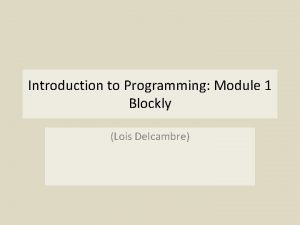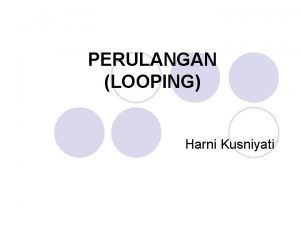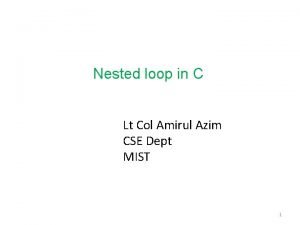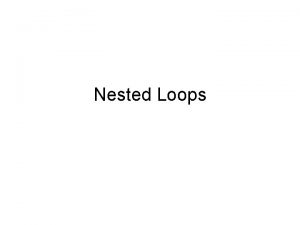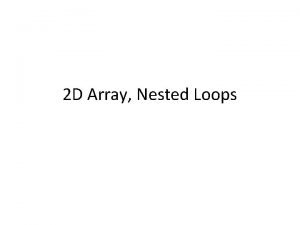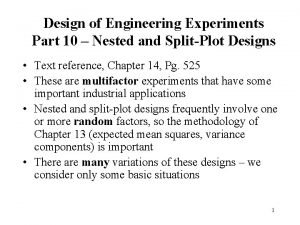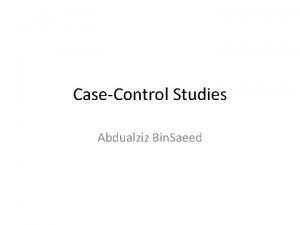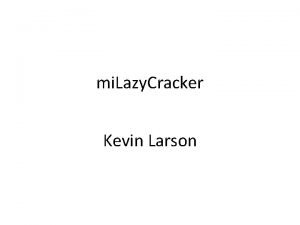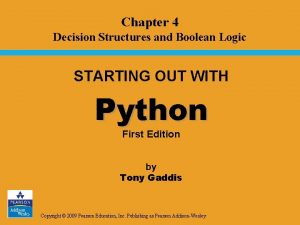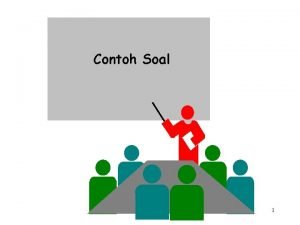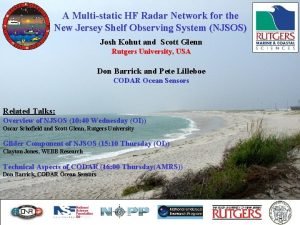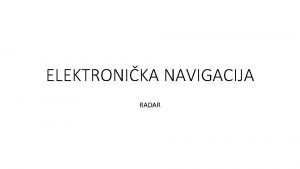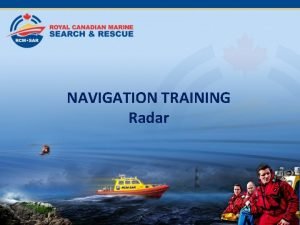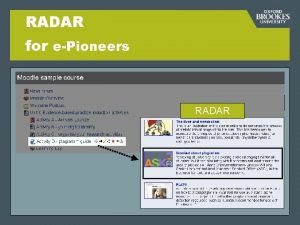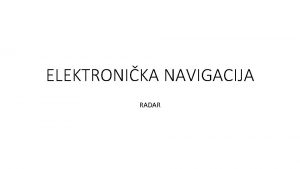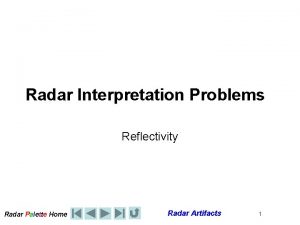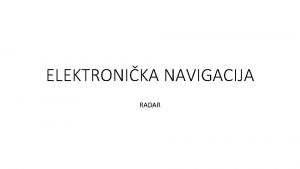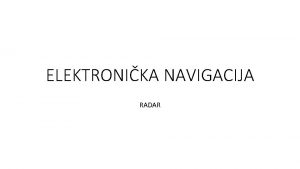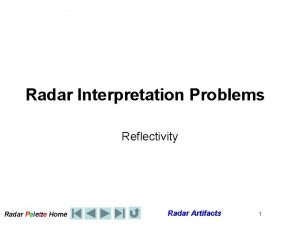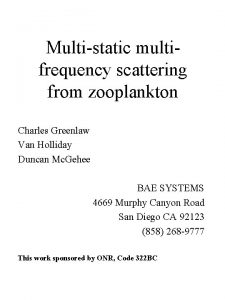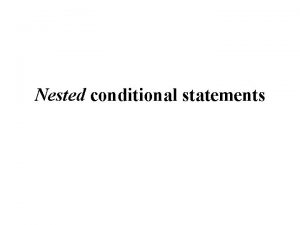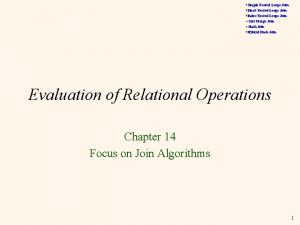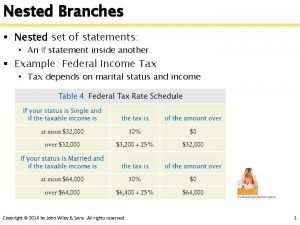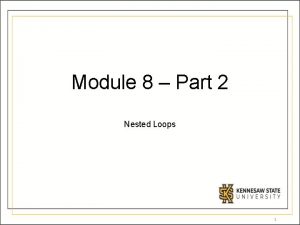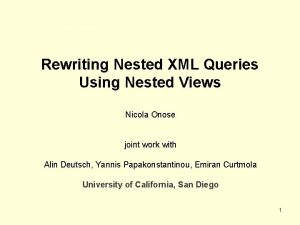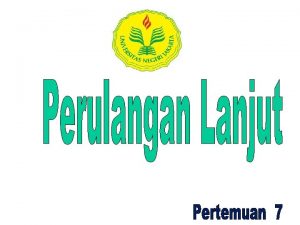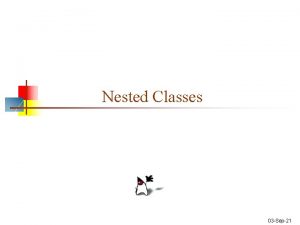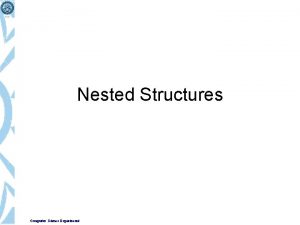Recent Results from a Nested MultiStatic HF Radar







































- Slides: 39

Recent Results from a Nested Multi-Static HF Radar Network for the Northeast Observing System (NEOS) Hugh Roarty Josh Kohut & Scott Glenn Coastal Ocean Observation Lab Rutgers University Science web site http: //marine. rutgers. edu/cool Operational web site http: //www. thecoolroom. org

VOTE Scott Glenn for Governor of California Where is Gray Davis? Where is Scott Glenn? “I’m right here Arnold and I am coming after you!

Frequency: 25 MHz Range: 50 km Resolution: 1. 5 km Time Step: 1 hour

Test 1998 1999 2000 2001 2002 2003

Frequency: 5 MHz Range: 200 km Resolution: 6 km Time Step: 3 hour

1998 1999 2000 2001 2002 2003 Radials Radials


NEOS HF Radar Network Partners • Applied Mathematics, Inc. • Army Corp. of Engineers • CODAR Ocean Sensors • Go. MOOS • NOAA • Stevens Institute of Technology • Rutgers University • United Stated Coast Guard R&D Center • University of Connecticut • University of Maine • University of Massachusetts, Dartmouth • University of North Carolina, Chapel Hill • University of Rhode Island

5 MHz Long-Range Bistatic Buoy

5 MHz Long-Range Bistatic Buoy

Block Island, RI 5 MHz Long-Range CODAR Install

Block Island, RI 5 MHz Long-Range CODAR Install



Validation: Contribution of Vertical and Horizontal Shear

2 0 0 1 S u m m e r Ex p e r i m e n t

2001 Summer Experiment Site Depth Instrument COOL 1 10. 1 m RDI ADCP Tuckerton COOL 2 14. 9 m Son. Tek ADP 5 MHz Long-Range CODAR COOL 3 18. 0 m RDI ADCP COOL 4 20. 7 m Son. Tek ADP COOL 5 21. 9 m RDI ADCP COOL 1 COOL 2 Brigantine 25 MHz Standard CODAR COOL 3 n COOL 4 COOL 5 n n Long-Range and Standard CODAR Thermistors at all 5 locations, spaced at 1 m intervals ADCP n n n 1 meter bins Continuously sampled every 5 s 3 hour Centered Average

6 km Long-Range Sea. Sonde 5 m 2. 5 m BIN 20 BIN 19 BIN 18 BIN 17 BIN 16 12 m BIN 15 BIN 14 BIN 13 BIN 12 BIN 11 BIN 10 BIN 9 COOL 5 NTS

Long-Range CODAR and ADCP Comparison VERTICAL SHEAR

Tuckerton COOL 1 COOL 2 COOL 3 Brigantine COOL 4 COOL 5

Radial

Ideal Pattern, 8. 27 cm/s RMS Difference Measured Pattern, 7. 74 cm/s RMS Difference


Location of Bin 16 Location of Bin 11 Temperature °C

July 28 th to 30 th: Low Shear August 1 st to 3 rd: High Shear

Bin 16 Bin 11

Bin 16 Bin 11

RMS Difference 3. 92 cm/s RMS Difference 6. 30 cm/s

Long-Range CODAR and ADCP Comparison HORIZONTAL SHEAR

Tuckerton COOL 1 COOL 2 COOL 3 Brigantine COOL 4 COOL 5

BIN 16 BIN 15 Long-Range Sea. Sonde BIN 19 BIN 18 2. 5 m BIN 20 BIN 19 BIN 14 BIN 17 BIN 18 BIN 13 BIN 16 BIN 17 BIN 12 BIN 15 BIN 16 BIN 11 BIN 14 BIN 15 BIN 10 BIN 13 BIN 14 BIN 9 BIN 12 BIN 13 BIN 12 BIN 11 BIN 10 BIN 9 COOL 4 COOL 3 4 km COOL 5 4 km NTS

RMS Difference Between CODAR & Bin 16 BIN 15 BIN 19 11. 29 cm/s BIN 14 BIN 20 BIN 18 BIN 13 BIN 17 BIN 12 RMS Difference 6. 07 cm/s BIN 11 BIN 10 BIN 9 BIN 16 BIN 15 BIN 14 BIN 13 RMS Difference Between CODAR & Bin 16 COOL 4 4 km BIN 11 BIN 10 BIN 9 6. 89 cm/s COOL 3 BIN 12 COOL 5 4 km

RMS Difference Between 5 MHz CODAR and ADCP Horizontal Shear Above Measure Horizontal Shear Below Measure Vertical Shear Above Measure 9. 29 cm/s (8) 7. 30 cm/s (21) Vertical Shear Below Measure 11. 60 cm/s (17) 6. 51 cm/s (77) (Number of data points shown in parentheses)

Standard CODAR and ADCP Comparison


BIN 16 BIN 15 Standard Sea. Sonde Long-Range Sea. Sonde BIN 20 BIN 19 BIN 14 BIN 18 BIN 13 BIN 17 BIN 12 BIN 16 BIN 11 BIN 10 BIN 9 RMS Difference Between Long. Range CODAR and Bin 16: 7. 74 cm/s RMS Difference Between Standard CODAR and Bin 16: 6. 79 cm/s BIN 15 BIN 14 BIN 13 BIN 12 BIN 11 BIN 10 BIN 9 COOL 3 4 km COOL 4 4 km COOL 5

Tuckerton COOL 1 COOL 2 Brigantine COOL 3 COOL 4 COOL 5

Tuckerton 5. 9 cm/s Brigantine 7. 2 cm/s

Conclusions The HF Radar network I within NEOS is growing with the help of strong collaboration between operators, data managers and users n Use of Measured Antenna Patterns Improved Comparison n Decreased Vertical Shear due to Strong Stratification Led to Closer ADCP/HF Radar Comparisons n Differences Between ADCP and HF Radar Measurements are shown to Depend on the Strength of the Horizontal Shear n
 A friend emails you the results
A friend emails you the results Pulse doppler radar vs mti
Pulse doppler radar vs mti Advantages of non coherent mti radar
Advantages of non coherent mti radar Trends in project portfolio management
Trends in project portfolio management After a skydiving accident laurie
After a skydiving accident laurie Is college worth it synthesis essay
Is college worth it synthesis essay Emerging trends in mis
Emerging trends in mis Recent demographic changes in the uk
Recent demographic changes in the uk Recent trends in ic engine
Recent trends in ic engine Passive voice in the news
Passive voice in the news Recent advances in ceramics
Recent advances in ceramics Foreign trade
Foreign trade Mpgu
Mpgu Myips schoology login
Myips schoology login Recent developments in ict
Recent developments in ict Https://drive.google.com/drive/
Https://drive.google.com/drive/ Advantages of scanning and skimming
Advantages of scanning and skimming Geotaphonomy
Geotaphonomy Recent developments in object detection
Recent developments in object detection Udin generate icsi
Udin generate icsi Time and space complexity
Time and space complexity Dame meaning in baa black sheep
Dame meaning in baa black sheep For bersarang
For bersarang For loop in c
For loop in c Flowchart nested if
Flowchart nested if Nested cross-validation
Nested cross-validation Eecs 1019
Eecs 1019 Struct
Struct Nested linked list
Nested linked list What is nested loop
What is nested loop Nested loops python
Nested loops python Quantifiers discrete mathematics exercises
Quantifiers discrete mathematics exercises Two stage nested design
Two stage nested design Case control study
Case control study Card is not vulnerable to nested attack
Card is not vulnerable to nested attack Xml elements must be properly nested
Xml elements must be properly nested Decision structures and boolean logic
Decision structures and boolean logic Contoh soal nested loop
Contoh soal nested loop Contoh soal rancangan tersarang
Contoh soal rancangan tersarang Nested squares recursive formula
Nested squares recursive formula





















